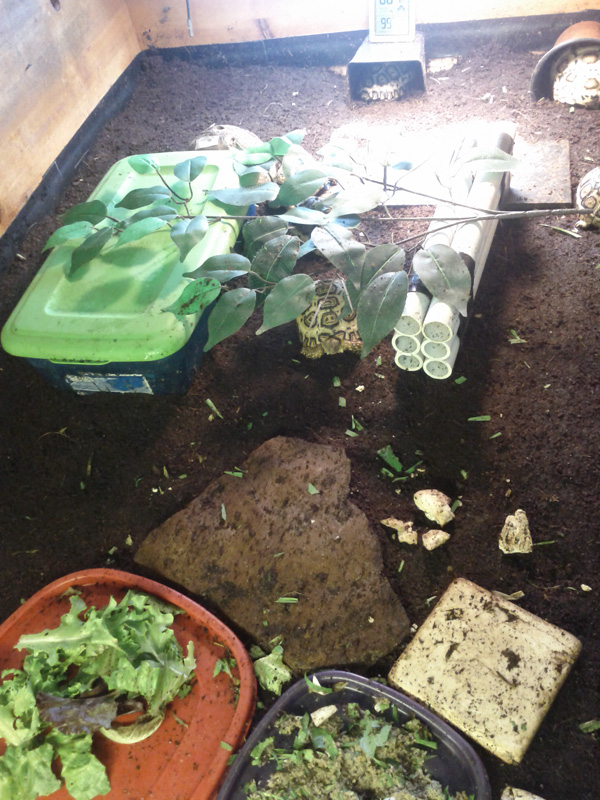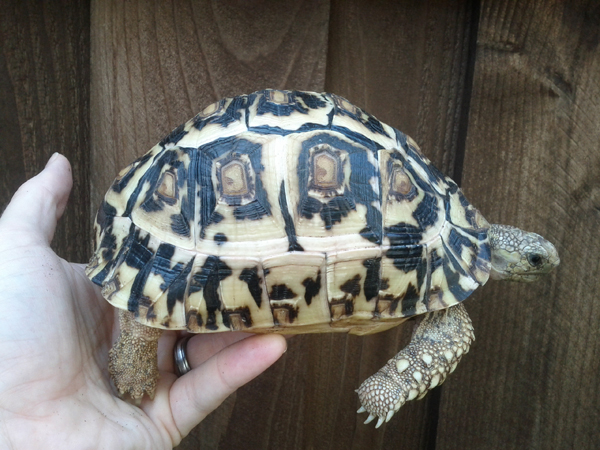Leopard Tortoise Housing Indoors

Housing leopard tortoises in captivity and having them grow and thrive has many challenges. With the proper setup it can be achieved with success.
Leopard Tortoise Housing Indoors for Hatchlings/Juveniles
There is a lot of conflicting information in books, industry magazines and on the internet as to what is the best way to raise a leopard tortoise hatchling in captivity. The debate that rages at the time of this writing is hot/dry vs hot/humid which will be discussed in detail a bit later. What everyone can agree on is these core requirements: adequate diet, sunshine (natural or artificial), exercise, and hydration.
When is comes to size of the indoor enclosure size does matter… the bigger the better. For a hatchling, I would recommend nothing smaller that a 20 gallon long terrarium which is 24″ x 12″ x 12″ . Keep in mind that in one year your little 2 inch hatchling can be 5 to 6 inches and weight a pound or more. At this size a 20 gallon terrarium will be too small. Personally I use a home built enclosure that measures 60″ L x 30″ W x 16″ H. An enclosure this size will allow for there to be different temperature zones so your Leopard tortoise can self regulate their body temperature. Keep in mind tortoises are poikilothermic – animals that regulate their body temperature using external sources such as sunlight or a heated surface.
Here is my enclosure set up:
Daytime heat source: 60w incandescent light from Target with a 8″ dome fixture from Home Depot set on a timer for 12 hours of heat/light per day
Nighttime heat source: 150w CHE from Ebay (new it was around $15 shipped) in a 8.5″ dome fixture with a ceramic socket connected to a Hydrofarm digital thermostat ($30 on Amazon)
Both heat sources are on the same end of the enclosure.
Humidity at least 80% even in the basking spot. I use a Acurite Hygrometer $10 Home Depot
UVB light – 18″ Reptisun T8 10.0 tube light hanging about 11 inches above the sub-straight and at the same end as the heat source and is on the same timer as the 60w incandescent light.
Additional lighting: At the cool side of the enclosure there is a regular florescent 18″ light.
Substrate: Zoo Med Eco Earth bricks 3 pack at PetSmart is around $7. I keep it damp enough for an earthworm to survive which will maintain the 80%+ RH.
Basking spot: Directly below the light is a flat dark granite tile with a surface temperature of 115F while the light is on.
Food dish: A plastic lid of a Tupperware container (easy access for the tort and easy cleaning for owner)
Water dish: 6″ round ceramic plant pot saucer $1 from Walmart
Humid Hide – Plastic Sterilite blue shoe box with green lid from Walmart $1. Assorted plastic plant pots turned on their side.
Additional decorations: Plastic (not silk) fichus branches from Hobby Lobby give more places for tort to hide and feel safe from predators like in the wild.
I prefer to get my supplies from big retailers and garden centers rather that pet supplies stores mainly due to cost and practicality. Since I raise my hatchings in a hot and humid environment I like to use plastic and stone for furnishing rather than wood or other natural materials that would rot or become full of mildew.

Leopard tortoise enclosure interior
As you can see in the photo at the top of this page, I have constructed a cover thus turning my open tortoise table into a closed chamber. This allows for the increase of humidity which I believe has a direct impact on preventing or minimizing pyramiding which is extremely prevalent in captive raised leopard tortoises. Having a top on the enclosure also retains the heat better so my electric bill is more reasonable.
You can read more about pyramiding and its prevention here: Leopard Tortoise Pyramiding
The closed chamber is not 100% air tight. That could be potentially dangerous. There are plenty of cracks, nooks and crannies that will allow for air exchange. Also there is plenty of air exchange when the PVC framed plastic top is removed in the daily care i.e. feeding, soaking etc. As stated above with this set-up I’m able to maintain 80% + humidity in the basking area during daytime and over 90% humidity at night with the CHE on. I was able to produce this beautiful, smooth shelled specimen that reached a SPL of 6 3/4 inches and a weight of 785 grams at 15 months.

Smooth Leopard Tortoise
